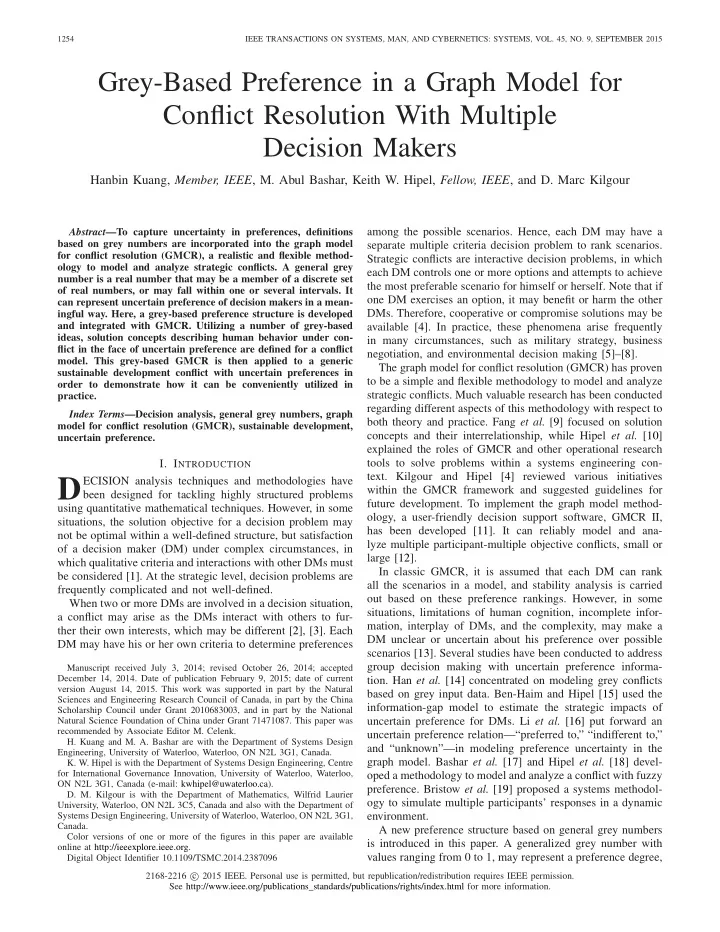

1254 IEEE TRANSACTIONS ON SYSTEMS, MAN, AND CYBERNETICS: SYSTEMS, VOL. 45, NO. 9, SEPTEMBER 2015 Grey-Based Preference in a Graph Model for Conflict Resolution With Multiple Decision Makers Hanbin Kuang, Member, IEEE , M. Abul Bashar, Keith W. Hipel, Fellow, IEEE , and D. Marc Kilgour among the possible scenarios. Hence, each DM may have a Abstract —To capture uncertainty in preferences, definitions separate multiple criteria decision problem to rank scenarios. based on grey numbers are incorporated into the graph model for conflict resolution (GMCR), a realistic and flexible method- Strategic conflicts are interactive decision problems, in which ology to model and analyze strategic conflicts. A general grey each DM controls one or more options and attempts to achieve number is a real number that may be a member of a discrete set the most preferable scenario for himself or herself. Note that if of real numbers, or may fall within one or several intervals. It one DM exercises an option, it may benefit or harm the other can represent uncertain preference of decision makers in a mean- DMs. Therefore, cooperative or compromise solutions may be ingful way. Here, a grey-based preference structure is developed available [4]. In practice, these phenomena arise frequently and integrated with GMCR. Utilizing a number of grey-based ideas, solution concepts describing human behavior under con- in many circumstances, such as military strategy, business flict in the face of uncertain preference are defined for a conflict negotiation, and environmental decision making [5]–[8]. model. This grey-based GMCR is then applied to a generic The graph model for conflict resolution (GMCR) has proven sustainable development conflict with uncertain preferences in to be a simple and flexible methodology to model and analyze order to demonstrate how it can be conveniently utilized in strategic conflicts. Much valuable research has been conducted practice. regarding different aspects of this methodology with respect to Index Terms —Decision analysis, general grey numbers, graph both theory and practice. Fang et al. [9] focused on solution model for conflict resolution (GMCR), sustainable development, concepts and their interrelationship, while Hipel et al. [10] uncertain preference. explained the roles of GMCR and other operational research tools to solve problems within a systems engineering con- I. I NTRODUCTION text. Kilgour and Hipel [4] reviewed various initiatives ECISION analysis techniques and methodologies have D within the GMCR framework and suggested guidelines for been designed for tackling highly structured problems future development. To implement the graph model method- using quantitative mathematical techniques. However, in some ology, a user-friendly decision support software, GMCR II, situations, the solution objective for a decision problem may has been developed [11]. It can reliably model and ana- not be optimal within a well-defined structure, but satisfaction lyze multiple participant-multiple objective conflicts, small or of a decision maker (DM) under complex circumstances, in large [12]. which qualitative criteria and interactions with other DMs must In classic GMCR, it is assumed that each DM can rank be considered [1]. At the strategic level, decision problems are all the scenarios in a model, and stability analysis is carried frequently complicated and not well-defined. out based on these preference rankings. However, in some When two or more DMs are involved in a decision situation, situations, limitations of human cognition, incomplete infor- a conflict may arise as the DMs interact with others to fur- mation, interplay of DMs, and the complexity, may make a ther their own interests, which may be different [2], [3]. Each DM unclear or uncertain about his preference over possible DM may have his or her own criteria to determine preferences scenarios [13]. Several studies have been conducted to address group decision making with uncertain preference informa- Manuscript received July 3, 2014; revised October 26, 2014; accepted December 14, 2014. Date of publication February 9, 2015; date of current tion. Han et al. [14] concentrated on modeling grey conflicts version August 14, 2015. This work was supported in part by the Natural based on grey input data. Ben-Haim and Hipel [15] used the Sciences and Engineering Research Council of Canada, in part by the China information-gap model to estimate the strategic impacts of Scholarship Council under Grant 2010683003, and in part by the National Natural Science Foundation of China under Grant 71471087. This paper was uncertain preference for DMs. Li et al. [16] put forward an recommended by Associate Editor M. Celenk. uncertain preference relation—“preferred to,” “indifferent to,” H. Kuang and M. A. Bashar are with the Department of Systems Design and “unknown”—in modeling preference uncertainty in the Engineering, University of Waterloo, Waterloo, ON N2L 3G1, Canada. graph model. Bashar et al. [17] and Hipel et al. [18] devel- K. W. Hipel is with the Department of Systems Design Engineering, Centre for International Governance Innovation, University of Waterloo, Waterloo, oped a methodology to model and analyze a conflict with fuzzy ON N2L 3G1, Canada (e-mail: kwhipel@uwaterloo.ca). preference. Bristow et al. [19] proposed a systems methodol- D. M. Kilgour is with the Department of Mathematics, Wilfrid Laurier ogy to simulate multiple participants’ responses in a dynamic University, Waterloo, ON N2L 3C5, Canada and also with the Department of Systems Design Engineering, University of Waterloo, Waterloo, ON N2L 3G1, environment. Canada. A new preference structure based on general grey numbers Color versions of one or more of the figures in this paper are available is introduced in this paper. A generalized grey number with online at http://ieeexplore . ieee . org. values ranging from 0 to 1, may represent a preference degree, Digital Object Identifier 10.1109/TSMC.2014.2387096 2168-2216 c � 2015 IEEE. Personal use is permitted, but republication/redistribution requires IEEE permission. See http://www.ieee.org/publications_standards/publications/rights/index.html for more information.
Recommend
More recommend